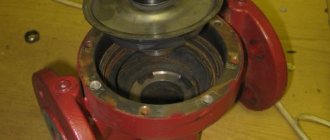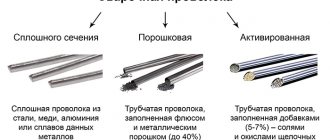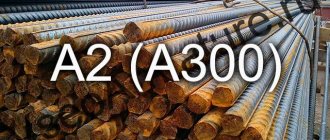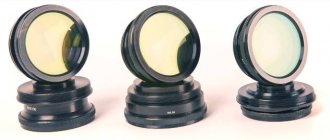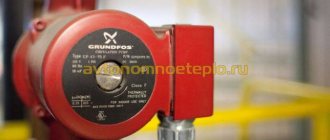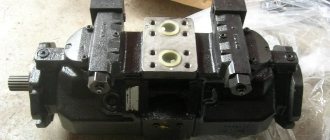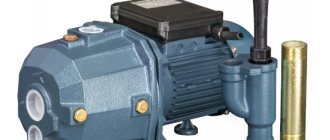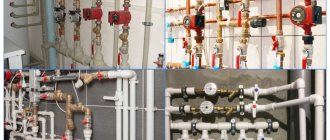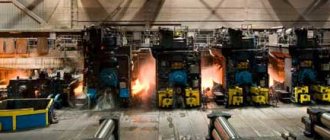Model from Aquario When the heating system involves the use of a heating boiler, its efficient operation is ensured by forced circulation of the coolant. This can only be organized with the help of a pumping unit, which makes the entire system energy-dependent. When the lights are turned off, there is a risk of the heating system freezing. The use of a 12-volt circulation pump equipped with a battery helps solve this problem. This technical feature allows us to call it emergency. In the event of a power outage, the installation will continue to operate, reducing emergency risks.
Small power allows you to save electricity, while it is quite enough to provide heating for a two-story house with an area of up to 100 square meters. m. But the scope of application of the described device can be much wider. Today it is used in air conditioning systems, small-volume irrigation systems, water supply systems, water pumping systems, when connecting cold fountains, in aquariums and solar heater installations. But most often, 12 volt pumps are used specifically for emergency maintenance of heating systems.
12 volt circulation pumps for heating: design features and advantages
Many autonomous heating systems, in which the water is heated in a boiler or boiler, are equipped with circulation pumps, which makes it possible to increase the efficiency of not only the water heating equipment, but also the entire system as a whole. So that when operating such a pump, which makes the system it serves energy-dependent, you do not find yourself in a situation where the latter simply stops working if there is no electricity in the central network, you can equip it with a 12-volt circulation pump for heating. When using such a pump, which is powered by a battery, the heating system will function normally in the absence of a central power supply.
Low voltage circulation pump combines high flow rate with low electricity consumption
The tasks of the circulation pump, operating at a voltage of 12 volts, include not only maintaining the operation of the heating system when the main electric pump is not working, but also protecting the pipes from freezing water in them as a result of prolonged downtime at sub-zero temperatures. Consuming a small amount of electricity, a 12-volt circulation pump has enough power to provide heating even for a two-story house, the total area of which does not exceed 100 m2.
Operating principle of uninterruptible power supplies
An uninterruptible power supply for a heating pump (like any other) consists of a battery of one capacity or another (battery) and an automation unit. In normal mode, while the pump is powered from the mains, the electronic unit charges the UPS battery using the built-in charger and keeps it “in reserve”. When the standard voltage is lost, the same automation unit switches the consumer to power from the battery.
As a rule, the voltage and type of current required by the consumer differ from the voltage at the terminals of the backup battery, therefore almost any uninterruptible power supply contains an electronic converter - an inverter. Its task is to convert the DC voltage of the battery into that required to power the consumer (for a household circulation pump, usually 230 V / 50 Hz).
When the normal power supply is restored, the switchback occurs, and the battery is charged again. Thus, the UPS is always ready for operation and can supply power to the electrical machine at any time. How long can a UPS power the same circulation pump? Everything will depend on the battery capacity. There are uninterruptible power supply models with external batteries that can power the load for days.
One of the clear examples of such a system is a computer UPS. As soon as the mains voltage disappears, the computer will switch to battery power, giving the user time to correctly shut down and turn off the machine.
Design features and benefits
A 12-volt circulation pump for heating, when compared with devices operating from a 220-volt power supply network, differs in a number of design and technical features.
- In such a hydraulic machine there are no oil seals and there is a drive equipped with permanent magnets. Due to the use of a magnetic drive, the 12-volt circulation pump has fairly low energy consumption.
- All elements of the internal structure of such equipment are placed in an absolutely sealed housing made of polymer materials.
- Due to the absence of a 12-volt brush circulation pump in the design of the drive electric motor, this device operates completely silently.
- 12-volt heating circulation pumps are capable of pumping water at temperatures up to 120° without compromising their technical condition.
- Subject to compliance with operating rules, the average service life of such hydraulic machines is 100,000 hours in continuous operation.
- The unit that controls the operation of such a pump is built into its housing, making equipment maintenance easier.
Brushless DC Circulation Pump for Heating or Hot Water Systems
Along with the above advantages, the 12 volt circulation pump is distinguished by a number of positive characteristics, which are worth dwelling on in more detail.
The impeller of most models of heating circulation pumps operating at twelve volts is manufactured using a patented technology that involves its fixation on a ball made of high-strength ceramic. Thanks to this unique design, the moving parts of the pump are highly resistant to abrasion. Thus, virtually no wear products from the elements of its internal structure enter the hydraulic part of the 12-volt pump, which significantly increases the reliability of the equipment and increases its service life.
12 Volt circulation pump with variable speed control
To protect the 12-volt circulation pump from overheating, it contains elements that automatically turn off the device if an emergency occurs. In addition, such pumps are equipped with automatic elements that prevent idling (without water).
The design of the 12-volt circulation pump for heating also includes temperature sensors that automatically stop the operation of the device if the temperature of the heating medium rises to a critical level, and turns on the electric pump when it drops to an acceptable level.
This type of circulation pump can be powered either from a central power supply or from a separate battery. To avoid being in a situation where the equipment is damaged if both power sources are used simultaneously, you should ensure that one of these sources is turned off in a timely manner.
Connection diagram for a low-voltage pump via a car battery
A special module is responsible for starting the 12-volt circulation pump in the most gentle mode, which reduces the value of the starting current. Thanks to the presence of such a module, a soft start of the pump can be carried out even with minimal values of the voltage supplied to the electric motor.
Advantages and disadvantages of different types of UPS
Each device has pros and cons:
- Backup UPS. It is distinguished by increased efficiency, practically does not make noise and does not heat up, is inexpensive, but at the same time it takes a lot of time when switching and distorts the shape of the output voltage. In such devices there is no way to adjust the amplitude and frequency of the current.
- Linear interactive source. It does not make noise and maintains high efficiency, stabilizes the voltage through an autotransformer. The disadvantages include low accuracy, long switching period and trapezoidal voltage shape. Also, inexpensive models may exhibit frequency deviations.
- Inverter units. Advantages: accuracy of stabilization, operation in a wide range of mains voltage, instant switching and absence of interference at the output with an ideal voltage supply form. But such a device is expensive and constantly makes noise from the fan.
In order for the heating pump to work normally, the UPS must produce a sinusoidal signal, and if the output signal is converted into a meander, stepped sine wave or trapezoid, the pump motor will be overloaded, which will lead to rapid equipment failure. Only the inverter unit produces the required signal parameter, so if the power supply in the house is often turned off, it is worth purchasing just such a UPS. Backup sources are suitable for buildings with rare interruptions in the central power supply.
What to consider when choosing
In order for a 12-volt heating circulation pump to demonstrate high efficiency during operation, the choice of such a device must be based on the parameters of the heating system. It should also be borne in mind that a 12-volt circulation pump may not be installed in every heating system.
The choice of a specific model of a 12-volt circulation pump for heating is mainly influenced by the following parameters of the heating system:
- water flow, which determines the performance of the selected electric pump;
- the value of water pressure at which the coolant can pass through the entire heating circuit;
- the difference between the coolant temperatures at the boiler outlet and at its inlet.
Before choosing a circulation pump, the above parameters of the heating system must be calculated, for which simple formulas are used.
Basic parameters for selecting a circulation pump
The calculation of water consumption in the heating system, which is designated by the letter Q, is performed as follows: the power of the boiler or gas water heater used in the system is divided by the temperature difference at the outlet of the heating equipment and at its inlet. As an example, we can consider the option of calculating water consumption in the heating system of a house with an area of 100 m2, the ceiling height of which is 2.7 m. Heating of such a house can be provided by a boiler with a power of 12 kW. The difference in temperature of water at the outlet and inlet to the boiler, as a rule, is about 150. Substituting all the initial values into the formula (Q = 12:15), we determine that the water flow will be 0.8 m 3 per hour (or 13.5 liters per minute). Based on this parameter, it is already possible to select a circulation pump with the appropriate technical characteristics.
The water pressure, which depends only on the hydraulic resistance created by the elements of the heating system, and not on the number of storeys of the building, for private houses can be taken equal to 4 m of water. Art.
Reasons for the high efficiency of 12 volt circulation pumps
With very little energy consumption, 12-volt circulation pumps used to equip heating systems are highly efficient. This is due to a number of factors.
If the design of a standard circulation pump contains sealing elements, bearings and brushes, which absorb a significant amount of energy during its operation, then the design of a 12-volt pump does not have such elements. The rotation of the rotor of the electric motor of the circulation pump, operating at a voltage of twelve volts, is carried out by a non-contact magnetic drive. The latter ensures high energy efficiency of the 12-volt circulation pump, as well as its ability to work with different power sources and start in the most gentle mode.
Built-in pump microprocessor ensures smooth starting with low starting current
The use of a non-contact magnetic drive in equipping circulation pumps for heating, operating at a voltage of 12 volts, gives such devices a number of other advantages, such as the absence of vibration and sparking during operation, almost complete absence of noise, high reliability, which is explained by the absence of rubbing elements in the design of the device. Another important advantage of 12-volt circulation pumps is that they protect the heating boiler from explosion when the coolant boils.
Circulation pump (12 volts)
Let's answer the question where a 12-volt circulation pump is used, this will be discussed below. Forced circulation of coolant through the heating system is provided by a pump. It belongs to the category of an energy-dependent element of any type of boiler - gas or electric. Power outages mean that the flow of coolant stops, and if the temperature outside is sub-zero, the system begins to defrost. If there is no electricity for more than a day, and the water has not been drained first, the pipes simply burst. In order to avoid such an unpleasant situation, emergency equipment should be used. In particular, in the heating system it will be a 12-volt circulation pump equipped with a battery. Even in the absence of electricity, the pump continues to operate, ensuring the movement of the coolant and eliminating the risk of damage to the entire system.
The pump power of 12 volts is quite enough to completely heat a residential building or building with an area of 80-100 sq.m. The low energy consumption and ease of operation of the pump made it possible to use it in various fields, but the main one is heating.
Video 1 Heating circulation from a 12-volt battery
Factory models
You can buy an uninterruptible power supply suitable for its characteristics in heating and plumbing stores. They are also sold in online stores. Final prices vary depending on the manufacturer, type of equipment and technical specifications. We will look at the most popular models and give their estimated cost.
Energy PN-1000 with 75 A battery
We have a simple uninterruptible power supply with a good battery capacity of 75 A/h. With a pump power of 100 W, the battery life will be about 8 hours. The peak power is 1000 W, which is enough for any reactive load. At the output, the device produces a pure sine wave. And it refers to line-interactive UPSs, characterized by high efficiency and an affordable price. The cost of the model on the domestic market is about 260,000 rubles.
Modifications with different battery capacities are also available for sale:
- At 100 A/h – up to 11 hours when operating with a load of 100 W;
- At 55 A/h – up to 6 hours when operating with a load of 100 W;
- At 200 A/h - up to 23 hours when operating with a load of 100 W.
If power outages in your area are frequent and long-lasting, we recommend paying attention to the latest modification - its cost is 36-37 thousand rubles.
SVC DI-600-F-LCD
A compact uninterruptible power supply that can work with boilers and pumps, ensuring continuous circulation of coolant in the heating system. It belongs to the category of linear-interactive and produces a pure sine wave at the output without any distortion. The equipment does not require user intervention in its operation and provides an output voltage error of no more than 10% - this is the norm for pumps, but for boilers it could be less. The speed of switching to operation from the battery does not exceed 20 ms.
There is no built-in battery here; an external battery with a capacity of up to 200 A/h is connected to the uninterruptible power supply - this will ensure up to 24 hours of autonomous operation of the heating system. The peak load for this model should not exceed 360 W. The estimated cost of the model is 6.5-7 thousand rubles.
Tieber T-1000
If you need an uninterruptible power supply with a maximum capacity, from which the pump can operate for up to two days, you should look at this model. It works with two batteries with a capacity of up to 200 A/h each. The manufacturer recommends using maintenance-free gel batteries, as they do not emit harmful gases into the atmosphere - this is important for residential premises.
The maximum load power is 800 W. An uninterruptible power supply can power fairly powerful pumps and heating boilers, as well as units of water heated floors. The output voltage form is a pure sine wave, as required by pumping equipment motors. The device is designed for floor installation; batteries are placed next to it. The maximum charging current is 12 A/h.
Technical Features and Benefits
In many ways, the circulation pump is similar to a car pump, especially since the power is the same. The difference lies in the pump housing, which is completely plastic and completely sealed (the car pump is an aluminum capsule), and the absence of oil seals.
It is strictly forbidden to immerse the pump in water or other liquids.
The silent operation of the pump is ensured by the absence of metal brushes, and the tightness of the device allows it to work with coolants whose temperature reaches 120 0 C.
The estimated operating time of the pump is 100 thousand hours, which in terms of round-the-clock operation is 10 years. This is the minimum period declared by the manufacturer; in reality, such pumps operate for about 15 years.
Photo 1 Technical features and advantages of the pump
In addition, we can highlight the following advantages of a circulation pump:
- reliable operation (built-in protection against boiling water);
- safety of equipment operation;
- non-volatile – the pump operates on 2 sources.
Now we should talk about each property of the pump separately.
Reliability of operation
Experts always note that everything that moves breaks quickly. When the pump is turned on, it is completely immobilized - there is no vibration, and therefore there is no noise during operation. At the same time, it is highly efficient and starts even at a minimum voltage in the network, which is especially important for gas boilers. You will learn how to choose gas double-circuit boilers in our article.
Equipment safety
The emergency equipment is equipped with an automatic relay that stops operation the moment the temperature reaches its maximum limit. After the indicators return to normal, the automation starts the pump again.
This indicator is necessary not only for the uninterrupted operation of the pump itself, but also for the integrity of the boiler. Standard electric boilers are equipped with circulation pumps with voltages up to 220 V. When the coolant begins to boil, the closed system is simply not able to shut off the water supply and stop the operation of all equipment. At this moment, intense steam release begins. The smallest consequence will be the formation of air pockets that can simply be released, but most often the pressure pushes the sectional radiators apart, which breaks the seal.
Another consequence of boiling coolant is a boiler explosion. This happens not so much because the water temperature is approaching a critical level, but because of the sudden disconnection of the boiler from the network. That is why the heating system must be equipped with low-power circulation pumps with a built-in uninterruptible power supply.
Energy independence
The 12 volt circulation pump can operate either from the mains or from a battery. The main task is to switch to a specific power source in time. If this is not done correctly, when the battery is not disconnected when the power is turned on, the pump will instantly fail.
Control
The operation of the device is ensured by a built-in module that reduces the inrush current. Even at zero voltage in the network, the pump starts and ensures forced circulation of the coolant in the network.
If you are away for a long period of time, completely turn off the electricity in the house to eliminate the risk of damage to the pump.
Feature of the pump device (12 volts)
The uniqueness of the design lies in the mounting of the impeller on a ceramic ball. This solution allows us to solve the issue of abrasion and clogging of hydraulics. During the entire operation of the equipment, minimal maintenance is required, which is most often caused by violation of operating rules.
Photo 2 Example of a 12 Volt pump model
How to use the device correctly
It would be a mistake to assume that such emergency pumps are suitable for any equipment. Indeed, their main area of application is heating, but the choice of pump in this case depends on several factors:
- water pressure power;
- consumption;
- difference in coolant temperatures at the inlet and outlet.
In order to determine the pump you are looking for, you should carry out simple calculations. For example, let's take a residential building with an area of 120 sq.m., where there are 3 rooms and the ceiling height is 2.8 meters. The optimal boiler power sufficient for heating a house is 12 kilowatts with a standard coolant temperature difference within 150 0 C.
Determining water consumption
12 kW (boiler power): 150 (difference) = 0.8 m 3 / h
0.8 m 3 = 800 l/h = 13.5 l/min
Next, compare this indicator with the technical indicators of the pump.
The water pressure does not depend on the number of floors of the building. The main indicator of resistance in the heating system itself. For residential buildings, the figure of 4 meters is justified.
Why is even low power enough for a circulation pump?
Despite the fact that the circulation pump uses extremely little energy, it is quite efficient equipment and is responsible for the safety of the entire system.
The operation of the motor of a standard circulation pump is ensured by oil seals and bearings that drive the rotor shaft. This is an energy-intensive system that is designed for direct current.
Unlike traditional pumps, the 12-volt pump has a unique structure, where there are no brushes or seals, and the motor rotates under the influence of a non-contact magnetic drive. It is this indicator that ensures the pump’s energy independence, the ability to work alternately with different energy sources and start even at minimum voltage.
Conclusion, reviews, tips
Recommendations for installing circulation pumps in the heating system are not a whim of specialists, but a mandatory measure. This will not only preserve its integrity during a long power outage, but will also save the boiler from explosion if the coolant boils, and you can read about how to correctly calculate a pump of this type in the article.
Popular UPS models for gas boilers
In this section we will look at the most popular UPS models for gas boilers. The micro-reviews we compiled will help you make the right choice.
Teplocom 300
Here we have the simplest UPS for gas and any other heating boilers. It has an extremely simplified design and is devoid of any adjustments. At the output, the UPS produces a pure sine wave, making it ideal for gas boilers and any other electrical equipment. Connection to the network is carried out using a Euro plug; a socket is provided on board to connect consumers. The battery is connected via a screw terminal block.
Advantages and characteristics of the model:
- Output power – 200 W;
- Efficiency – more than 82%;
- Charge current – 1.35 A;
- Built-in deep discharge protection;
- Battery capacity – from 26 to 100 A/h.
If you do not need fine adjustments and other functions, pay attention to this UPS for gas boilers - at a cost of 10-11 thousand rubles, it will be an excellent solution for powering boiler equipment with a maximum power consumption of up to 200 W.
SVC W-600L
The presented UPS for gas boilers has excellent technical characteristics. It contains protection against high-frequency interference and other interference, complete galvanic isolation from the network, and overload protection. The device can be used to protect computer networks and telephone lines. There is no built-in battery on board; it is purchased and connected separately. The efficiency of the device is 95%, which is a very high figure.
The switching time to battery power for this UPS is from 3 to 6 ms; a gas boiler will not notice anything in such an insignificant period of time. The time to fully charge the battery is 6-8 hours, the charging current is 6 A. Two standard sockets are provided for connecting consumers. Monitoring of network parameters and output voltage is provided using an informative liquid crystal display. The optimal capacity of the connected battery is 45-60 A/h, but more is possible.
This UPS is suitable not only for powering gas boilers, but also for any other electronic devices that are sensitive to the quality of the supply voltage. The cost of the model is about 7,000 rubles. – an excellent uninterruptible power supply for home use.
The need for an autonomous power supply for the circulation pump
The functioning of the heating system of a country house, if this system is built on the basis of the use of a heating boiler and forced circulation of the coolant, depends on the reliable operation of the circulation pump . The circulation pump is powered by electricity from the city network of 220 volts. Power outages, which occur quite regularly, lead to the circulation pump turning off. Coolant circulation stops. As a result, the coal boiler may even fail. If there is no electricity for quite a long time, the heating system and the entire house, including the water supply, etc., will freeze.
Thus, the issue of ensuring uninterrupted power supply to the circulation pump .
Here is a selection of materials:
Everything you need to know about heating and climate control Features of the selection and maintenance of boilers and burners. Comparison of fuels (gas, diesel, oil, coal, wood, electricity). Do-it-yourself ovens. Coolant, radiators, pipes, heated floors, circulation pumps. Chimney cleaning. Conditioning
Using an autonomous gasoline or diesel electric generator does not solve the problem, since the generator cannot operate constantly due to noise and high fuel consumption, and the pump requires constant power, albeit small. In low constant load mode, an autonomous power plant operates with very low efficiency.
I have worked on two options for solving the problem. The first is the use of a 12 volt circulation pump , the second is the use of an uninterruptible power supply system and special energy-efficient circulation pumps
Wall-mounted and floor-standing online UPS “Shtil” for pumps
The use of the Shtil single-phase UPS models recommended below guarantees a high level of uninterrupted power supply and operational reliability of not only circulation pumps and electronically controlled heating boilers, but also any other power-sensitive electrical equipment of engineering systems in city apartments, private residential buildings or offices.
Model range of wall-mounted online UPS
The SW series is represented by fairly compact low-power devices - 250 VA, 500 VA and 1 kVA. This output power, even taking into account the high starting currents of the electric motors, several times higher than the rated ones, will be quite sufficient to power any circulation pump of the heating system.
New UPS SW250SL (250 VA) Active power, kW 0.225 Form factor on-line topology (double conversion) Limit input voltage range, V90-295 Nominal output voltage, V230 Output voltage setting range, V210-240 (requires IC-SNMP/Web monitoring card or IC-SNMP/mini-USB) Accuracy of output voltage stabilization, % ± 2 Output voltage shape pure sine wave Maximum output current, A1.2 Availability of built-in batteries Electronic automatic bypass Warranty period, months 24 Get a manual 16,200 ₽ Add to cart New UPS ST250 (250 VA) Active power, kW0.225 Form factor floor-standing Topology on-line (double conversion) Limit input voltage range, V90-295 Nominal output voltage, V230 Output voltage setting range, V210-240 (requires IC-SNMP/Web or IC-SNMP/mini-USB monitoring card) Accuracy output voltage stabilization, % ± 2 Output voltage form pure sine wave Maximum output current, A1.2 Presence of built-in batteries (optional) Electronic automatic bypass Warranty period, 24 months Get a manual 18,900 ₽ Add to cart New UPS SW250 (250 VA) Active power, kW 0.225 Form factor wall-mounted ologyon- line (with double conversion) Limit input voltage range, V90-295 Nominal output voltage, V230 Output voltage setting range, V210-240 (requires IC-SNMP/Web or IC-SNMP/mini-USB monitoring card) Output voltage stabilization accuracy, %± 2Output voltage form pure sine waveMaximum output current, A1.2Presence of built-in batteries (optional)Electronic automatic bypass Warranty period, months 24 Get a manual 16,480 ₽ Add to cart New UPS SW250LD (250 VA) Active power, kW0.225Form factor wall-mounted Topology on-line (with dual transformation) Limit input voltage range, V90-295 Nominal output voltage, V230 Output voltage setting range, V210-240 (requires IC-SNMP/Web or IC-SNMP/mini-USB monitoring card) Output voltage stabilization accuracy, %±2 Output voltage shape pure sine wave Maximum output current , A1,2 Availability of built-in batteries no Electronic automatic bypass Warranty period, months 24 Get the manual 17,580 ₽ Add to cart UPS SW500SL (500 VA) Active power, kW 0.4 Form factor wall-mounted Topology on-line (with double conversion) Limiting input voltage range, V 90-295 Nominal output voltage, V220 Output voltage setting range, V220-240 Accuracy of output voltage stabilization, % ± 2 Output voltage shape pure sine wave Maximum output current, A2.3 Availability of built-in batteries Electronic automatic bypass Warranty period, months 24 Get manual 21,280 ₽ Add to cart
Sources
- https://www.shtyl.ru/support/articles/osobennosti-vybora-ibp-dlya-nasosa/
- https://VashUmnyiDom.ru/elektropitanie/ups/besperebojnik-dlya-nasosa-otopleniya.html
- https://bespereboynik.ru/dlya-nasosov/
- https://OmShantiDom.ru/montazh-i-remont/ibp-dlya-cirkulyacionnogo-nasosa.html
- https://Acums.ru/bespereboyniki-i-bloki-pitaniya/dlya-nasosa-otopleniya-tsirkulyatsionnogo-kak-vybrat-ibp-kakoy-akkumulyator
- https://nasos-kitai.ru/proizvoditeli-nasosov/besperebojnik-dlya-nasosa-otopleniya-i
- https://teplo.bast.ru/articles/ibp-cirkulyacionnogo-nasosa-otopleniya
- https://remont-system.ru/komplektuyushchie/bespereboynye-bloki-pitaniya-dlya-cirkulyacionnyh-nasosov
[collapse]
Options for providing autonomous circulation
Circulation pump 12 volt
This option is good for a small home. The effective length of the heating circuit should not exceed 100 m, the required circulation speed is about 0.6 cubic meters. m per hour (boiler up to 20 kW).
I installed a 12 (twelve) volt circulation pump from a Bosch car 0392020034.
Disadvantages of the pump:
- The pump is quite noisy. The room where it stands must be soundproof. My pump is installed in a boiler room that is separate from the house.
- The documentation for the pump does not say anything about its ability to operate continuously. In general, the 25 thousand hours between failures promised by the instructions is quite enough (that’s five years of actual operation), but it is unknown whether it can be driven continuously without turning it off. It has been working for me since 10/01/2011. I bought two at once, installed one, and kept the second as a reserve in case of combustion.
Pump connection diagram
Important! Install the pump exactly as shown in the diagram, with the outlet pipe facing up. Otherwise, air may accumulate in the pump, which will impede circulation. Don't forget to install the fuse shown in the diagram. The pump may short out, and then, if there is no fuse, a fire is inevitable.
From a 75 A/h car battery, taking into account the fact that a trickle-type water pump is also connected to this battery through a converter, the pump operates autonomously (without external sources of electricity) for more than three days. Power outages for longer periods of time are extremely rare in our country. And if it happens, the battery can always be recharged from a car or a backup electric generator.
Added 01/10/2012 . Brushed electric motors, of course, are not suitable for continuous operation. Based on the results of the experiment, it turned out that graphite dust, which is formed when the brushes are activated, begins to accumulate in the pump commutator and leads to unstable operation. In a car environment, this problem does not arise, since vibration shakes off the dust. To prevent this problem from occurring in the heating system, the pump had to be rearranged. Until I moved it, I had to shake it regularly to shake off graphite dust from the collector. It must be placed with the contacts facing up. Then the graphite dust falls off and does not accumulate on the collector. The experiment continues, the pump has been operating for the third month.
Added on 03/01/2012 . The pump stopped. I replaced it because I was ready for it, I had a spare, and the system has taps for quick replacement. Turned off the taps and replaced. The old pump was opened. The brushes worked completely. This was the reason for the stop. Changed the brushes. I bought graphite ones for the drill and cut them into the desired shape. Installed and checked. The old pump is ready to go back into service. We draw a conclusion. The brushes on this pump last for 5 months. Then you can simply replace it with a new one, since the pump is not very expensive, and you can change the brushes.
Now 12 volt circulation pumps without brushes, with electronic control, are on sale. I will study the issue. I will write an article based on the results. Subscribe so you don't miss out.
Circulation pump for heating: device characteristics
The electric motor of the device does not have brushes: this device is somewhat reminiscent of a cooler from a system unit. There is no thunder, no sparks - and this is in the complete absence of a brake, so it can be attributed to a perpetual motion machine running from a power source.
What about the temperature? At an operating temperature of the coolant of 100 or even 120 degrees above zero, excess pressure does not arise, since such a pump only works with open heating systems.
These are all advantages, but there are also disadvantages: the body, unfortunately, is plastic, not metal. There would be aluminum here - and the invention would not have a price!
Do you need a stabilizer if you have a UPS?
The power supply to country houses is characterized not only by frequent interruptions, but also by low quality input voltage. However, the UPS should not be considered a panacea for these ills.
Not all models can “pull” too low a voltage (less than 170-180V).
With such a drawdown, the device will go into error, turn off and beep. Accordingly, the boiler will turn off along with it, or it will immediately switch to the battery.
At the same time, the UPS itself may indicate that it is designed to operate at a voltage of 180V. What's the matter, were they deceived in the store?
So if you really have serious and persistent problems with the input U
Otherwise, the boiler will be constantly powered only by batteries. And this will not increase their service life.
The inverter stabilizer calmly levels the parameters to normal, starting with drawdowns up to 90V.
Bosch 0392020034: was an automobile, now a heating one
A 12-volt Bosch 0392020034 circular pump would work well with the heating system of a small house if the length of the heating circuit did not exceed hundreds of meters, the boiler power was no more than 20 kilowatts, and the flow rate was 0.6 cubic meters per hour.
Everything would be fine, but there are significant shortcomings in the car design:
- It makes loud noise, so the boiler room should be well insulated or even located in a neighboring building. Then it will be comfortable to live in the house.
- It cannot work continuously, but it will serve its 25,000 hours properly.
If we translate it into years, it will be less than 5 years. If you don't drive it 24 hours a day, it will last longer.
If it fails (read, burns out) - buy a new one, since it cannot be repaired, but it is better to buy two devices at once, so as not to torment yourself with searching for something that cannot be returned.
What kind of heater should you make for your home?
Almost all types of heaters can be made at home. The exception is the inverter, because its design is very complex. Most modern devices create heat with virtually 100% efficiency. All of them have an electric heating element, the main part of which is nichrome wire.
The simplest homemade heater for a garage and a house made from this wire has the following structure:
- Horizontal ceramic pipe with a diameter of 12 cm.
- Four supports.
- Wire wound around a pipe.
- A wire with a plug is connected to the wire.
Such a heater is unsafe, because in addition to the fact that the wire can heat up to 1,000 °C, it also remains open. Contact with it threatens not only burns, but also electric shock. Also, such a device can burn down part of the house.
Unlike most heating devices, it does not heat the air around it, but gives off heat to surrounding objects. It only heats what is needed.
Autonomous heating device
This heater is designed for 12 volt current. Thanks to this, it can be connected to a battery. It can be used in rooms where there is no heating and where renovations are being carried out, as well as in the garage or any room in the house. Its power is not enough to heat the entire room. It does not create infrared rays. It only heats the air.
To make it you need to take:
- Metal can. It could be a coffee can. Its height and diameter should be 20 and 10 cm, respectively. These values may deviate upward or downward. not use a jar made of plastic, cardboard or any other material . This is because they are poor conductors of heat.
- Bracket. It can be a U-shaped part of a children's metal construction set.
- Bayonet cartridge.
- Car brake light lamp. It is designed for 12 volts. Its power is 25 W.
- 2 A fuse.
- Sleeve made of insulating material.
- Cable. The cross-sectional area of one wire must exceed 1 mm².
Sequence of manufacturing an autonomous heater
A 12 volt device is made as follows:
- Drill 20-30 holes in the side wall of the can. Their diameter should be 3 mm.
- Make a hole in the bottom of the jar. It is drilled in the center of the bottom. The diameter should be equal to the diameter of the bolt that will secure the bracket.
- Fix the bracket at the bottom of the can.
- A cartridge is secured to the top of the bracket. This element must be positioned so that the lamp does not touch the walls of the container.
- A hole is drilled in the side wall of the can at the level of the top of the bracket so that the bushing for the cable fits in it.
- A sleeve is inserted into this hole and an electrical wire is pushed through it, through which a current of 12 volts will flow. The cable will be connected to the socket.
- Screw in the lamp and close the jar with a lid.
- A fuse is connected to the cable break.
The 12 volt heater is ready. Now all you have to do is connect it to the battery and wait 10 minutes. During this time, the homemade garage heater will warm up. When using a device with an operating voltage of 12 volts, you need to monitor the battery voltage. It should not fall below 10 volts. Otherwise, the current source cannot be restored.
How to make an uninterruptible power supply step by step instructions
First of all, it is worth understanding that it is quite possible to assemble a UPS yourself, but this will require certain knowledge. If a person does not have knowledge in this area, it is not worth creating an uninterruptible power supply with your own hands; time and money will be wasted.
In addition, it is worth understanding that a system created in this way will have a rather unpresentable appearance. it will lack a number of functions, and it will not work automatically, but in manual mode.
To create a UPS you will need:
- Inverter 12 to 220 volts. Inverters are different, they differ in power and shape of the output signal; in a particular case, you will need a device with a peak power of 600 W, and a working power of at least 300 W.
- Rechargeable batteries. The larger the battery capacity, the longer the uninterruptible power supply will work in offline mode. Equipment with a capacity of 45A/hour will work for approximately 8 hours, with a capacity of 95A/hour - a day. It is best to choose gel batteries; they last much longer, but are also more expensive.
- Battery charger. Of course, it must match the capacity of the battery itself.
The process of creating an uninterruptible power supply with your own hands can be divided into the following stages:
- There are two symbols + and - on the inverter; they must be connected with a powerful wire to the corresponding symbols on the battery.
- The boiler plug should be connected to the power supply on the inverter; after pressing the “turn on” button, the equipment will begin to work.
- The inverter and boiler are running, but the battery is gradually discharged. After the battery runs out or the power supply returns, you need to connect the charger to the battery.
It is worth paying attention to the following nuances during assembly:
to fasten parts, use thick copper wires; the connections between the wires and the equipment must be very reliable, so they should be given special attention; connections should be checked after some time, since there is a risk of metal oxidation in these places, which can impair the operation of the system.
If you assemble the UPS yourself from the specified parts, the savings will be approximately 30-50%.
Oil device
A homemade oil heater is a fairly functional and safe device. It has high efficiency and is therefore suitable for those rooms where various household appliances are repaired.
Its design consists of a sealed housing, inside of which there is oil and heating elements.
Before making a heater with your own hands, you need to prepare the following materials:
- Sealed container. You can use an aluminum or metal battery or a car radiator as it.
- Technical or transformer oil.
- Heating element 4 pcs.
- Electric motor with a power of 2-2.5 kW. Instead, you can use a pump with the same power.
- Switch.
- Set of drills.
- Corners or profile pipe with dimensions 40x40 mm.
- Two tubes. Must withstand temperatures of 100-150 °C.
You will have to work with a drill and a welding machine.
Algorithm for manufacturing an oil heater
- Frame welding. Before this, draw a diagram of the frame. To do this, you should start from the size of the selected container and the height at which the case should be placed. The frame can be made in the form of two rectangles. The width of the rectangle should be greater than the depth of the selected container, and the length should be greater than the height of the container. The main part will be inserted into rectangles. These parts of the frame should be at the ends of the container. Each rectangle must have two legs. It is advisable to connect them with one corner, which will run along the body.
- Cutting 7 holes in the selected container. 4 of them must be such that a heating element can fit in one hole. They can be located in the corners of the radiator. 2 holes are needed for the pump. They are made at the bottom of the radiator. Another hole is needed to fill the oil. It needs to be done at the highest point of the radiator. You can use a grinder or welding to cut holes. The best option is autogen.
- Making a mount for fixing the pump. To do this, metal plates with holes cut in them for bolts are welded to the container. These plates should be located close to the pump holes.
- Fixing the pump and connecting it to the radiator. To connect it you need to use two tubes. They can be welded to the radiator and connected through shut-off valves to the pump. You can weld fittings to the holes intended for the pump and attach tubes to them.
- Mounting heating elements. They are secured using bolted connections. The easiest way to mount those heating elements is the base of which has a thread and is a kind of large bolt. In this case, a fitting with internal thread is welded to the holes in the radiator. A nut may also work. A heating element is screwed into it.
- A fitting with an external thread is placed and welded onto the oil filling hole. There will be a lid on it. It can be made from a pipe. To do this, an internal thread is cut at one end. It should be the same as the thread on the fitting. The pipe must have a larger diameter than the fitting. A metal square plug is welded to the second end.
- Check the tightness of all holes. To do this, create a lot of pressure in the middle of the oil heater.
- Heating elements are connected. To do this, use the parallel connection method.
- Connect the voltage regulator and cable with plug.
- Place the housing on the frame and ground it.
- Pour oil.
The oil heater is now ready and can be used. Over time, it may fail and require repair. Repair comes down to replacing heating elements or pumps. Sometimes it may be necessary to improve the tightness of connections. This type of repair is not very difficult.
